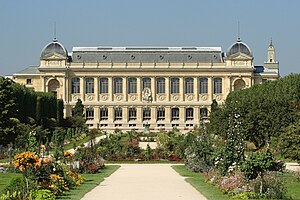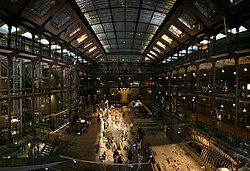Jardin des plantes
This article needs additional citations for verification. (June 2014) |
Jardin des Plantes | |
 The exterior of the Grande Galerie de l'évolution architect Louis-Jules André. | |
| Established | 1635 |
|---|---|
| Location | Paris, France |
| Type | botanical garden |
| Public transit access | Jussieu Austerlitz |
| Muséum national d'histoire naturelle network | |
| |
The Jardin des Plantes (French: garden of plants) is the main botanical garden in France. It is one of seven departments of the Muséum national d'histoire naturelle. It is situated in the 5ème arrondissement, Paris, on the left bank of the river Seine and covers 28 hectares (280,000 m²).
Garden plan
The grounds of the Jardin des Plantes includes four galleries of the Muséum: the Grande Galerie de l'Évolution, the Mineralogy Museum, the Paleontology Museum and the Entomology Museum. In addition to the gardens there is also a small zoo, Ménagerie du Jardin des plantes, founded in 1795 by Bernardin de Saint-Pierre from animals of the royal menagerie at Versailles.
The Jardin des Plantes maintains a botanical school, which trains botanists, constructs demonstration gardens, and exchanges seeds to maintain biotic diversity. About 4500 plants are arranged by family on a one hectare (10,000 m²) plot. Three hectares are devoted to horticultural displays of decorative plants. An Alpine garden has 3000 species with world-wide representation. Specialized buildings, such as a large Art Deco winter garden, and Mexican and Australian hothouses display regional plants, not native to France. The Rose Garden, created in 1990, has hundreds of species of roses and rose trees.
History
Founded in 1626, the garden was not planted by Guy de La Brosse, Louis XIII's physician, until 1635 as a medicinal herb garden. It was originally known as the Jardin du Roi. In 1640 it opened to the public. After a period of decline, Jean-Baptiste Colbert took administrative control of the gardens. Dr. Guy-Crescent Fagon was appointed in 1693, and he surrounded himself with a team of brilliant botanists, including Joseph Pitton de Tournefort, Antoine de Jussieu, Antoine Laurent de Jussieu and his son Adrien-Henri.
It includes the 6,963 specimens of the herbarium collection of Joseph Tournefort, donated on his death to the Jardin du Roi.[1]
The Comte de Buffon became the curator in 1739 and he expanded the gardens greatly, adding a maze, the Labyrinth, which remains today. In 1792 the Royal Menagerie was moved to the gardens from Versailles.
Access
| Located near the Métro stations: Quai de la Rapée, Jussieu, Place Monge and Gare d'Austerlitz. |
See also
Gallery
-
Plan of the Jardin des Plantes from 1820
-
The Mexican Hothouse built (1834–36) by Charles Rohault de Fleury, an early example of French glass and metal architecture
-
Map of the Jardin des Plantes
-
Inside the Grande Galerie de l'évolution
-
A fruiting tree of Trifoliate oranges
References
- ^ "Herbarium J.P. de Tournefort (1656-1708)". brill.com. Retrieved 29 September 2014.





